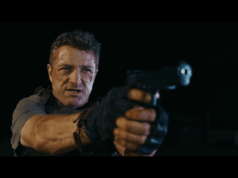“Comparing Fury to the other war-release this year, Lone Survivor, it’s strange to say how much more Fury achieves in the way of combat realism and depiction than the latter did.”
Brad Pitt deserved to be in one very good film concerning Nazi-occupied Germany and the events of World War II, and I’m glad that film wound up being David Ayer’s Fury, a thoroughly morose film about the brutalities of war without a shred of a moral compass present. From start to finish, this is an uncommonly miserable, violent film for mainstream sensibilities; I can see some people walking out because of how extreme the film manages to be at times. In a little over two hours, we see a corpse run over in mud, buildings destroyed with the remains of innocent casualties shown and implied, bullets piercing the limbs and shredding the innards of soldiers, men decapitated as quickly as they can blink, and men shooting other men against their will, all decorated with the cinematography of an overcast day and language as colorful as would be in a brothel filled with the evening’s sailors. Make no mistake, this is a movie that needs every one of its patrons to be strongly cautioned.
Set in April 1945, the final days of World War II, we are plunged into the middle of the action in Germany, focusing on a U.S. Army Sergeant named Don “Wardaddy” Collier (Brad Pitt), who leads his four squadmates in a heavily-armored, fully-equipped Sherman tank named “Fury.” His crew, known entirely in nicknames, is made up of the bible-thumping “Bible” (Shia LaBeouf), the obnoxious and off-color “Coon-Ass” (Jon Bernthal), the humble, Spanish-speaking “Gordo” (Michael Peña), and their new assistant driver, Norman Ellison (Logan Lerman), who has just gone from being the army’s typist to being on the frontlines of all the danger.
- Fury
- Written & Directed by
David Ayer - Cast
Brad Pitt, Shia LaBeouf, Logan Lerman - Release Date
18 October 2014 - Steve’s Score: 8.5/10
We travel with this brigade as they cruise through Germany, with the group initially despising Norman for his compassion towards Germans and his inherently pacifist nature. He can’t bring himself to shoot a captive German, nor can he get the courage to fire at young German boys who put a significant risk to his safety. Wardaddy finds himself frustrated at Norman and corrupts his innocence by forcing him to shoot the aforementioned captive German, effectively making Norman lose his innocence.
Right off the bat, there is an element I’ve long waited to see explored in a war film: how do you bring yourself to go about a mission or a specific task in the army when you yourself either do not agree with the act or cannot muster up the energy to do so? It was an element I was dying to see explored in The Hurt Locker, and optimistic for in Lone Survivor, but finally the idea has been presented in a way that is cold and honest, and actively shows the desensitization of a character in conjunction with the film’s audience.
The character of Norman enters the battlefield with an evident innocence but emerges with a severely damaged mind, with post-traumatic stress disorder everything but certain. At first, killing a man is unthinkable and amoral to him, but give him a little while, and it’s the immediate nature when you see someone you’re not familiar with. That’s almost the way we, the audience, feel during the film; at first, we flinch and gasp at the unpredictable explosions and the loudness of the setting, on top of jumping at all the killing taking place. Soon enough, however, we become desensitized to the violence, much like Norman, and carry on with the coldness of the environment accordingly.
*****
Fury‘s most commendable attribute, outside of its capable performances all across the board, is its lack of any moral justifications for the actions of its characters. Ayer conducts the film without much of a thematic resonance, simply content on showing the ugliness of war and the people involved with it, which makes for a very somber and morose moviegoing experience in terms of the themes proposed. This is also a fairly bold move, as many war films try to drape themselves with the cloak provided by a moral high ground. Not Fury; it can’t be burdened with such a thing.
Comparing Fury to the other war-release this year, Lone Survivor, it’s strange to say how much more Fury achieves in the way of combat realism and depiction than the latter did. While I enjoyed Lone Survivor for several reasons, predominately its crystal-clear camerawork and lack of shakiness in its videography, the film failed to create characters we could resonate with, and, in turn, failed at its main goal. Fury, while lacking in the character department most certainly, only to not to the extent of Lone Survivor, finds a great functionality in its material despite lacking in morals and focusing on characters who are so often contemptible, as well as creating equally-visible combat and suspense through its videography. We needed one hugely affecting war film this year, and let’s hope Fury achieves half the recognition of The Hurt Locker.







